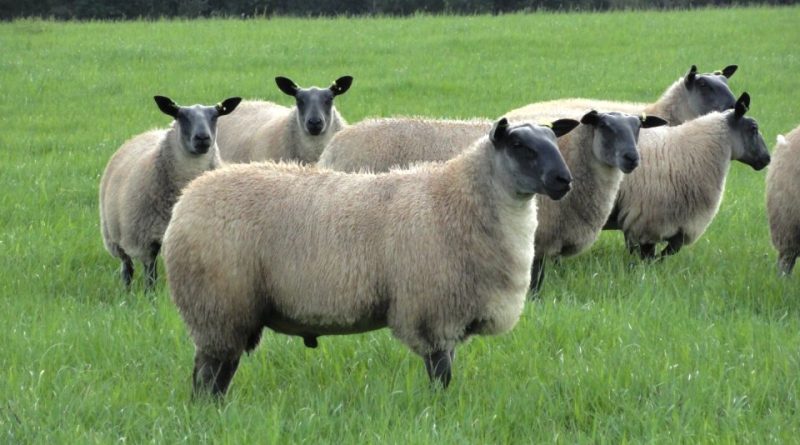Bleu du Maine
Bleu du Maine
La Bleu du Maine is a French sheep (Ovis aries Linnaeus, 1758) with a main aptitude for meat production.
Systematics –
From a systematic point of view it belongs to:
Eukaryota Domain,
Kingdom Animalia,
Phylum Chordata,
Mammalia class,
Order Artiodactyla,
Suborder Ruminantia,
Bovidae family,
Caprinae subfamily,
Genus Ovis,
Species O. aries,
Breed Bleu du Maine.
Geographic and Area Distribution –
The Bleu du Maine is a breed that from its birth in the nineteenth century in western France, in the regions of Maine-et-Loire, Mayenne and Sarthe, spread throughout France, in particular in Brittany, in the Center, in the south- east and in the Ardennes from where exports to Germany and Belgium began. The first commercial imports of the Bleu du Maine arrived in the UK in 1982.
This breed is mainly bred in the departments of Maine-et-Loire, Mayenne and Sarthe in the Pays de la Loire in western France. In particular in the areas surrounding the villages of Bazougers in the Mayenne department and Sablé-sur-Sarthe and Souvigné-sur-Sarthe in Sarthe up to the Orne area in southern Normandy.
Some garments have been exported to European countries and Ethiopia; in 2021 the breed was reported by Belgium, France, Holland, Ireland and the United Kingdom. Some specimens were exported to the UK in 1980 for breeding purposes, however the resulting sheep were found to be considerably less productive than the daughters of British breeds such as the Blue-faced Leicester, Border Leicester and British Milksheep.
Origins and History –
The Bleu du Maine sheep breed, as mentioned, is native to the historic region of Maine and shares some ancestry with the Rouge de l’Ouest. This sheep derives from the crossing in the early 19th century of the now extinct Choletais – named after the town of Cholet in the Maine-et-South Loire – with imported British Leicester Longwool or Dishley Leicester from 1855 to 1880. Towards the end of century there was some influence from Wensleydale, from which the characteristic blue muzzle derives.
It should be specified that the “Millenium Bleu” sheep are a cross between Beltex and Bleu sheep (or vice versa). These animals have the quality of the carcass of the Beltex, with the stretch and length of the Bleu.
In 1927 a herd book was started; the breed received official recognition from the Ministère de l’Agriculture in 1948. In 2015 the total population was estimated at just under 11,000 head, of which 1703 were registered in the herd book. In 2007, the conservation status of the breed throughout the world was indicated by the FAO as “not endangered”; in 2021 the state only for France was reported to DAD-IS as “in danger”.
Morphology –
The Bleu du Maine is a prolific sheep, characterized by the characteristic blue muzzle from which its name derives.
It is a large breed, characterized by a characteristic blue face, varying in color from almost black to a reddish tinge. The fleece is white. The muzzle is broad, with a slightly convex profile, lacking in wool like the legs.
It is a horned breed.
It features broad shoulders, a straight, regular back and an elongated pelvis.
The body is well proportioned with a good neck length leading to a strong, broad and long back with well sprung ribs giving considerable volume.
The average weight for pastures is 110-120 kg, while for females it is 80-90 kg.
Productive attitude –
The Bleu du Maine is raised mainly for the production of meat, with a productivity of around 1.88.
They are animals suited to the production of meat but can only be exploited with extensive outdoor farming and in areas with high forage potential.
Sheep produce excellent wool up to 9 kg in weight, of uniform quality and fiber length, and very soft.
The fleece weighs about 4–6 kg, with a wool length of about 80–100 mm and a fineness, according to the Bradford scale counted between 50 and 56 seconds, equivalent to about 27–30 μm.
Guido Bissanti
Sources-
– Wikipedia, the free encyclopedia.
– Daniele Bigi, Alessio Zanon, 2010. Atlas of native breeds. Cattle, horses, sheep and goats, pigs reared in Italy, Edagricole-New Business Media, Bologna.
Photo source:
– https://www.bleudumaine.co.uk/gallery/334/langley-dispersal/

